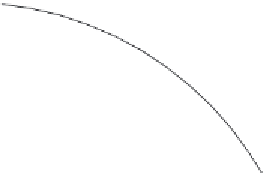Geology Reference
In-Depth Information
P
m
1
p
/2-
f
P
x
p
/2-
f
O
x
f
f
E
E
Δ
t
Figure 4.2 The e
ff
ect of the
m
⊥
component of polar motion on sidereal time.
is taken toward 90
◦
E longitude. The angular velocity vector of the Earth is then
written as
Ω
(
m
+
e
3
),
(4.1)
10
−
5
rad
where
s is the adopted mean rate of rotation of the Earth
and
e
3
is the unit vector in the
x
3
direction. The components
m
1
and
m
2
of the
vector
m
represent the small angular displacement of the rotation axis from the
x
3
reference axis, and
m
3
gives the relative change in axial rotation rate from the
mean rate
Ω=
7.292115
×
/
. Hence,
m
1
represents the angular displacement of the rotation axis in
radians, toward 0
◦
longitude, and
m
2
represents that toward 90
◦
E longitude.
To find the e
Ω
ects of polar motion on latitude and on sidereal time, it is of interest
to express the polar motion in terms of its component along the meridian of the
observatory, measured positive in the direction of the observatory,
ff
m
=
m
1
cosλ
+
m
2
sinλ,
(4.2)
and its component orthogonal to the meridian of the observatory, measured positive
in the direction of decreasing longitude,
m
⊥
=
m
1
sinλ
−
m
2
cosλ,
(4.3)
with λ representing the east longitude of the observatory.
The component
m
gives an increase in the latitude of the observatory. The com-
ponent
m
⊥
increases the sidereal time angle as illustrated in Figure 4.2. The polar
motion is very small compared with Earth's radius and this component of polar










Search WWH ::

Custom Search